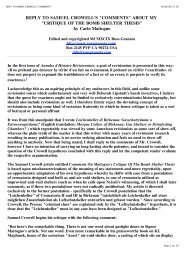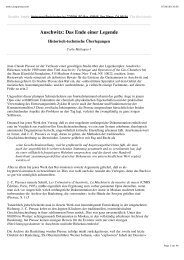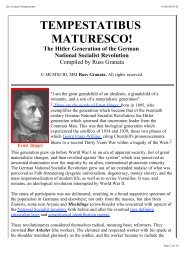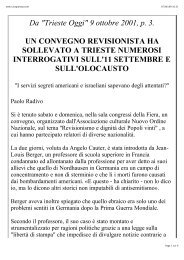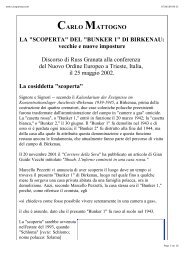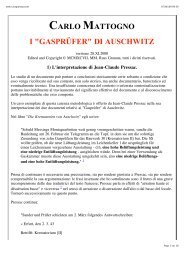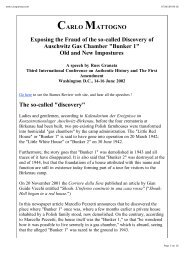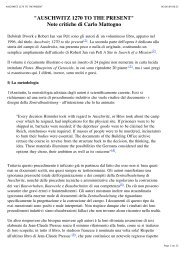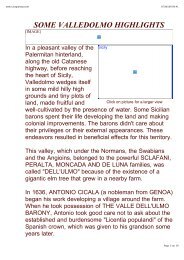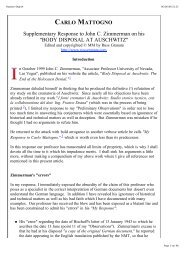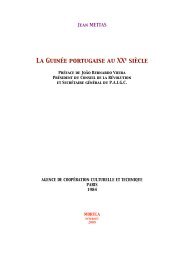The Robert Faurisson Critique of KL Majdanek: Eine ... - morula
The Robert Faurisson Critique of KL Majdanek: Eine ... - morula
The Robert Faurisson Critique of KL Majdanek: Eine ... - morula
Create successful ePaper yourself
Turn your PDF publications into a flip-book with our unique Google optimized e-Paper software.
<strong>The</strong> <strong>Robert</strong> <strong>Faurisson</strong> <strong>Critique</strong> <strong>of</strong> <strong>KL</strong> <strong>Majdanek</strong>: <strong>Eine</strong> historische<br />
07/06/09 08:06<br />
CARLO MATTOGNO<br />
<strong>The</strong> <strong>Robert</strong> <strong>Faurisson</strong> <strong>Critique</strong> <strong>of</strong><br />
<strong>KL</strong> <strong>Majdanek</strong>: <strong>Eine</strong> historische<br />
und technische Studie<br />
Edited and Copyrighted © MM by Russ Granata. All rights reserved.<br />
http://www.russgranata.com/<br />
info@russgranata.com<br />
POB 2145 PVP CA 90274 USA<br />
Amicus Plato, sed magis amica veritas<br />
[Plato is dear to me but truth is dearer still]<br />
Preface<br />
his article was to have been published in the September 1999 issue <strong>of</strong><br />
Vierteljahreshefte für freie Geschichtsforschung along with the "<strong>of</strong>fener Brief"<br />
[open letter] by co-author Jürgen Graf responding to the <strong>Robert</strong> <strong>Faurisson</strong> critique<br />
<strong>of</strong> our book, [1] but when it was not possible to include my response at that time due to<br />
space limitations, my response was postponed. For a while I decided to forego my<br />
response so as not to add further fuel to the polemics, and I held back until I saw the<br />
<strong>Faurisson</strong> reply to the Graf letter. [2] That is what convinced me that I too must present<br />
my point <strong>of</strong> view on this, and felt this was especially necessary since the critique by<br />
<strong>Robert</strong> <strong>Faurisson</strong> refers so much to parts <strong>of</strong> our book which I wrote; therefore it would<br />
not be proper that Jürgen Graf assume all the responsibility.<br />
An Emotional <strong>Critique</strong><br />
<strong>The</strong> June 1999 VffG article by R. <strong>Faurisson</strong> titled <strong>Eine</strong> Rivionistische Monographie über<br />
<strong>Majdanek</strong> (pp. 209-212) was supposed to be a critical review <strong>of</strong> <strong>KL</strong> <strong>Majdanek</strong>. <strong>Eine</strong><br />
Page 1 sur 22
<strong>The</strong> <strong>Robert</strong> <strong>Faurisson</strong> <strong>Critique</strong> <strong>of</strong> <strong>KL</strong> <strong>Majdanek</strong>: <strong>Eine</strong> historische<br />
07/06/09 08:06<br />
historische und technische Studie (Castle Hill Publisher, Hastings 1998), a book I wrote<br />
in collaboration with Jürgen Graf, but that <strong>Faurisson</strong> critique is imbued with emotional<br />
factors which have nothing to do with a sound scientific criticism whereby the author<br />
mixes up the argumentative plain with that <strong>of</strong> the personal, resulting in a belittling<br />
malevolent review <strong>of</strong> our work which is clearly based upon a superficial and incomplete<br />
reading.<br />
<strong>The</strong> Only Revisionist Work Without Merit<br />
For <strong>Robert</strong> <strong>Faurisson</strong> our book has practically no historical merit.<br />
<strong>The</strong> fact that we have made accessible the wealth <strong>of</strong> Polish literature concerning<br />
<strong>Majdanek</strong>;<br />
<strong>The</strong> fact that the problem <strong>of</strong> the number <strong>of</strong> the deceased has for the first time been<br />
scientifically confronted;<br />
<strong>The</strong> fact that for the first time we were able to reconstruct the history <strong>of</strong> the<br />
crematories;<br />
<strong>The</strong> fact that the problem <strong>of</strong> the gas chambers was for the first time scientifically<br />
studied based upon mainly heret<strong>of</strong>ore unpublished documentation as well as upon an<br />
accurate analysis <strong>of</strong> the installations;<br />
<strong>The</strong> fact that for the first time the origin <strong>of</strong> the story <strong>of</strong> the homicidal gassings has<br />
been delineated;<br />
<strong>The</strong> fact that for the first time (in Western historiography) there has been presented<br />
an exhaustive study concerning the supplying <strong>of</strong> Zyklon B to <strong>KL</strong> <strong>Majdanek</strong> (which<br />
corrects the results <strong>of</strong> the only Polish study dedicated to this topic);<br />
<strong>The</strong> fact that for the first time there exists a report on a historical-technical critique<br />
<strong>of</strong> the Erntefest;<br />
<strong>The</strong> fact that for the first time a general account <strong>of</strong> the <strong>Majdanek</strong> trials is presented -<br />
all <strong>of</strong> this is <strong>of</strong> no importance for him.<br />
In the 319 pages <strong>of</strong> our work, <strong>Faurisson</strong> found only "ein paar sehr interessanten Seiten"<br />
[a few interesting pages] in the chapter dedicated to the Erntefest, but he then hastens to<br />
declare his dissatisfaction because the conclusion <strong>of</strong> that chapter is introduced by an<br />
unsatisfactory "sehr wahrscheinlich" [most probably], obviously due to lack <strong>of</strong><br />
documents. This reproach is amazing: what does <strong>Faurisson</strong> expect - that I make up some<br />
documents in order to render conclusions more "satisfactory"? As to the rest - well, for<br />
example if someone who was critiquing the <strong>Faurisson</strong> thesis regarding the radical<br />
impossibility <strong>of</strong> homicidal gas chambers were to question just where those unregistered<br />
Jews ended up who were deported to Auschwitz, would not <strong>Faurisson</strong> also be constrained<br />
to respond that "sehr wahrscheinlich" they were transferred elsewhere? And if that<br />
conclusion doesn't make <strong>Faurisson</strong>'s conclusion regarding the Auschwitz gas chambers<br />
Page 2 sur 22
<strong>The</strong> <strong>Robert</strong> <strong>Faurisson</strong> <strong>Critique</strong> <strong>of</strong> <strong>KL</strong> <strong>Majdanek</strong>: <strong>Eine</strong> historische<br />
07/06/09 08:06<br />
unsatisfactory, then why on earth would he make mine unsatisfactory regarding the<br />
Erntefest?<br />
A False Problem<br />
<strong>Faurisson</strong> puts forth five arguments (which we shall examine) to show that no <strong>of</strong>ficial<br />
historian has regarded <strong>KL</strong> <strong>Majdanek</strong> as a "Vernichtungslager" [extermination camp] as<br />
though we had asserted that all <strong>of</strong>ficial historians had considered it as such! In reality we<br />
stated the following:<br />
"Der <strong>of</strong>fiziellen westlichen Geschichtsschreibung zufolge diente <strong>Majdanek</strong> zugleich<br />
als Arbeits- und Vernichtungslager" (p.14).<br />
[According to <strong>of</strong>ficial Western historiography, <strong>Majdanek</strong> was used as a work - as<br />
well as an extermination camp].<br />
Because <strong>Faurisson</strong> creates a false problem, his rebukes are unfounded right from the start;<br />
he misconstrues our intentions since the purpose <strong>of</strong> our book, as explicitly stated on page<br />
18, is to fill a historiographic gap; a valid endeavor since at that time no scientific study<br />
<strong>of</strong> <strong>Majdanek</strong> had as yet existed. In order to explain the situation, we concisely set out in<br />
our introduction, positions <strong>of</strong> both Western and Polish holocaust historiography -<br />
according to which, <strong>Majdanek</strong> was both a concentration and an extermination camp, or<br />
only an extermination camp - as well as that <strong>of</strong> a revisionist position.<br />
Although we took into consideration the most authoritative works, whether in book form<br />
or articles, it was not our intention, nor was there any reason whatsoever, to draw up a<br />
boring list <strong>of</strong> every author who had ever written a few lines about <strong>Majdanek</strong>. Regarding<br />
this, <strong>Faurisson</strong> rebukes us for not indicating to the reader the "völlige Verwirrung" [total<br />
confusion] which also reigns among <strong>of</strong>ficial historians who attribute to <strong>KL</strong> <strong>Majdanek</strong>, the<br />
function <strong>of</strong> a "Vernichtungslager" - a confusion which manifests itself concretely in the<br />
"Schwankungen in der vorgegebenen Zahlen der Opfer" (p. 209) [Variations in the<br />
claimed number <strong>of</strong> victims]. Actually, we devoted a whole paragraph to this question:<br />
("Die Zahlen der westlichen Historiker") [the Western historians' figures] on pages 88-89.<br />
<strong>The</strong> True Problem<br />
<strong>The</strong> essential problem discussed in our book is not whether <strong>Majdanek</strong> was a<br />
"Vernichtungslager", but whether the still existing gas chambers were or were not used<br />
for homicidal purposes. <strong>Faurisson</strong> on the other hand, not only creates a false<br />
Page 3 sur 22
<strong>The</strong> <strong>Robert</strong> <strong>Faurisson</strong> <strong>Critique</strong> <strong>of</strong> <strong>KL</strong> <strong>Majdanek</strong>: <strong>Eine</strong> historische<br />
07/06/09 08:06<br />
"Vernichtungslager" problem, but attempts to sustain his thesis by turning to inconsistent<br />
arguments. It is true that at the Nuremberg trial (argument 1, page 209) <strong>KL</strong> <strong>Majdanek</strong><br />
received practically no emphasis, but in documents URSS-29 and URSS-93, it was<br />
presented by the Soviets as an 'extermination camp' equipped with homicidal gas<br />
chambers. L. Poliakov (argument 2, page 209) wrote that, yes, <strong>Majdanek</strong> «n'était pas un<br />
camp d'extermination immédiate» [was not a camp for immediate extermination], but<br />
then added that «c'était un camp de travail, c'est-à-dire un camp d'extermination différée»<br />
[it was a labor camp, which is to say a camp <strong>of</strong> deferred extermination] [citation 1] and,<br />
following the Polish Commission <strong>of</strong> Inquiry, Poliakov attributed 200,000 victims to<br />
Madjanek for the years 1943 and 1944. [3] In 1963, Poliakov published an account <strong>of</strong> the<br />
Eichmann trial at Jerusalem in which he reported on the sentence [against Eichmann] in<br />
entire passages, and in point 126, referring to <strong>KL</strong> <strong>Majdanek</strong>, we read:<br />
«Le camp de <strong>Majdanek</strong>, un grand camp près de Lublin, servait également de lieu<br />
d'extermination de Juifs. Ils y étaient tués par fusillades et par les gaz. [...]. Des<br />
chambres à gaz furent egalement installées à <strong>Majdanek</strong>»<br />
[Camp <strong>Majdanek</strong>, a large camp near Lublin, served also as a center for<br />
extermination <strong>of</strong> Jews. <strong>The</strong>y were killed there by firing squads and by gas. [...]. Gas<br />
chambers were also installed at <strong>Majdanek</strong>] [4] [citation 2].<br />
As far as I am aware, Poliakov never contested this part <strong>of</strong> the verdict. G. Reitlinger<br />
(argument 3, page 209) emphasized that at <strong>Majdanek</strong> "crystals <strong>of</strong> Zyklon B were used<br />
although on a reduced scale" [5] and he is certainly not referring to disinfection<br />
chambers. M. Broszat [argument 4, page 209] in his famous letter to Die Zeit <strong>of</strong> 19<br />
August 1960 simply omitted the <strong>Majdanek</strong> camp from the list <strong>of</strong> camps in which, in his<br />
own words, there was "die Massenvernichtung durch Vergasung" [mass extermination by<br />
gassing]. [6] Nonetheless, in 1976 Broszat added the <strong>Majdanek</strong> camp also to the list<br />
(mentioned above in the "Preliminary Note") in the article "Organisierter Massenmord<br />
an Juden in nazionalsozialistischen Vernichtungslagern" [organized mass murder <strong>of</strong> Jews<br />
in National Socialist extermination camps] by Ino Arndt and Wolfgang Scheffler. [7]<br />
<strong>The</strong> citation (three words!) dealing with the 08 May 1950 sentence by a Berlin Tribunal<br />
(argument 5, page 209) refers to the Sobibor trial. So for <strong>Faurisson</strong>, three words written<br />
by some Berlin judges giving their verdict on Sobibor, and who had no expertise<br />
regarding <strong>Majdanek</strong>, have the same weight as conclusions drawn by Jerusalem judges<br />
who dedicated part <strong>of</strong> Session Number 63 <strong>of</strong> 02 June 1961 to this camp with the support<br />
<strong>of</strong> witness Yisrael Gutman, and apparently were as weighty as those more important<br />
conclusions <strong>of</strong> the Dusseldorf judges <strong>of</strong> whose judgement concerned exclusively<br />
<strong>Majdanek</strong>! With the same logic, <strong>Faurisson</strong> then places authors who have written a few<br />
Page 4 sur 22
<strong>The</strong> <strong>Robert</strong> <strong>Faurisson</strong> <strong>Critique</strong> <strong>of</strong> <strong>KL</strong> <strong>Majdanek</strong>: <strong>Eine</strong> historische<br />
07/06/09 08:06<br />
lines or who have simply mentioned Madjanek , on the same level as those who have<br />
devoted books and articles to it. In this regard he passes over in silence our citation on<br />
page 14 <strong>of</strong> the authoritative Enzyklopädie des Holocaust, which attributes to <strong>Majdanek</strong><br />
either a homicidal gas chamber or the character <strong>of</strong> a Vernichtungslager (p. 14).<br />
An Insignificant Concentration Camp?<br />
<strong>Faurisson</strong> asserts that in (Western) literature on the Holocaust, <strong>Majdanek</strong> has a totally<br />
secondary value or even an insignificant one, and that "die beiden Verfasser dieses<br />
Buches hätten den Leser darauf aufmerksam machen müssen (p. 209) [the authors <strong>of</strong> this<br />
book should have made the reader aware <strong>of</strong> this]. This rebuke reveals a divulging<br />
perspective antithetical to the scientific character <strong>of</strong> our work. If <strong>Faurisson</strong> is in the habit<br />
<strong>of</strong> writing for those who are not familiar with what is significant about concentration<br />
camps, then that's one <strong>of</strong> his personal choices which I respect, however he cannot claim<br />
to impose this upon us; our book is directed to the specialist essentially, and not to<br />
revisionists only.<br />
<strong>Faurisson</strong> takes as a personal rebuke our simple contention (which we made without the<br />
least intention <strong>of</strong> being polemic) that there had been no revisionist scientific work on<br />
<strong>Majdanek</strong>, and he feels the need to justify himself by adducing "Bedeutungslosigkeit"<br />
[insignificance] for this camp in the holocaust literature. <strong>The</strong> <strong>Faurisson</strong> take on this is the<br />
following: Official historians attribute hardly any importance to <strong>Majdanek</strong>, ergo neither<br />
should revisionists busy themselves with it! This implies a rather narrow historiographic<br />
viewpoint. It is as if the task <strong>of</strong> revisionism were to exclusively and uniquely negate that<br />
which <strong>of</strong>ficial historians have affirmed! In this way, adversaries are shown to be right<br />
when they define revisionism as negationism. <strong>The</strong> bottom line <strong>of</strong> the <strong>Faurisson</strong> rebuke is<br />
that our book is absolutely useless after all because the essential conclusions concerning<br />
<strong>Majdanek</strong> have already been announced by himself, so that "jetzt haben J. Graf und C.<br />
Mattogno sie lediglich bestätigt" (p. 209) [Jürgen Graf and Carlo Mattogno merely<br />
confirm this now]. <strong>Faurisson</strong> then lists his declarations on <strong>Majdanek</strong>, starting with 1975<br />
when he discovered "dass es in <strong>Majdanek</strong> keine Gaskammern zur Menschentötung gab<br />
oder gegeben haben kann" [that in <strong>Majdanek</strong> there were not and could not have been gas<br />
chambers for killing people], and then <strong>Faurisson</strong> rebukes us for not writing <strong>of</strong> his<br />
declarations as well as those <strong>of</strong> D. Felderer ( p. 210).<br />
And the pretense <strong>of</strong> that argument <strong>of</strong> his about the "Bedeutungslosigkeit" [insignificance]<br />
<strong>of</strong> <strong>KL</strong> <strong>Majdanek</strong> is transparent, because if <strong>Majdanek</strong> really had no significant<br />
historiographic weight, then why was Fred Leuchter sent to demonstrate that the<br />
presumed gas chambers were not [homicidal] by Ernst Zündel - in fact, upon the very<br />
suggestion <strong>of</strong> <strong>Robert</strong> <strong>Faurisson</strong> himself !<br />
Page 5 sur 22
<strong>The</strong> <strong>Robert</strong> <strong>Faurisson</strong> <strong>Critique</strong> <strong>of</strong> <strong>KL</strong> <strong>Majdanek</strong>: <strong>Eine</strong> historische<br />
07/06/09 08:06<br />
Unjustified Claims<br />
<strong>Faurisson</strong> maintains that revisionist historians had already resolved the <strong>Majdanek</strong> gas<br />
chamber problem before Jürgen Graf and I wrote this book. That passage deserves to be<br />
quoted in full:<br />
"Wenn nämlich ein <strong>The</strong>ma als nur zweitrangig oder als zu vernachlässigen<br />
angesehen wird, dann vernachlässigt man schon mal, sich ernsthaft damit zu<br />
befassen; und so ist es geschehen. Die Exterminationisten haben nicht auf <strong>Majdanek</strong><br />
beharrt. Wenn sich die beiden Verfasser des Buches zudem nur die Mühe gemacht<br />
hätten, gewissenhaft alles anzuführen, was Revisionisten, angefangen mit D.<br />
Felderer, R. <strong>Faurisson</strong> und F. Leuchter, hier und da über diese <strong>The</strong>ma geschrieben<br />
haben, dann hätten sie darüber hinaus schon den Beweis dafür in Händen gehabt,<br />
dass diese Historiker der revisionistischen Schule mit ihren schlagkräftigen<br />
Beweisen und ihrer rein sachlichen Forschungsarbeit das 'Problem der Gaskammern<br />
von <strong>Majdanek</strong>' ziemlich schnell gelöst hatten" (p. 212).<br />
[If a topic is judged to be merely <strong>of</strong> secondary importance or insignificant, then one<br />
fails to deal with it earnestly and this is what has happened. <strong>The</strong> exterminationists<br />
did not insist on <strong>Majdanek</strong>. If the authors <strong>of</strong> this book had carefully read everything<br />
that the revisionists, starting with D. Felderer, R. <strong>Faurisson</strong>, and Fred Leuchter had<br />
occasionally written on this topic, they would have already had the evidence that<br />
these revisionist historians, with their irrefutable pro<strong>of</strong>s and their purely material<br />
research had rather quickly solved the problem <strong>of</strong> the <strong>Majdanek</strong> gas chambers].<br />
Let us recapitulate: <strong>Faurisson</strong> first asserts that <strong>Majdanek</strong> was not significant - neither for<br />
<strong>of</strong>ficial, nor for revisionist historians; that nobody from either side occupied himself<br />
"seriously" with it; and then, in contradiction, he claims that certain above- mentioned<br />
revisionists have not only busied themselves with it "seriously", but even scientifically!<br />
But actually, <strong>Majdanek</strong> has had quite a central position ever since <strong>Faurisson</strong>'s first<br />
important public debate. It was in response to the <strong>Faurisson</strong> article "Le problème des<br />
chambres à gaz"où "La rumeur d'Auschwitz" [<strong>The</strong> Problem <strong>of</strong> the Gas Chambers, or <strong>The</strong><br />
Rumor <strong>of</strong> Auschwitz] which appeared in Le Monde, 29 December 1978, that G.Wellers,<br />
on the same page, stated:<br />
"Il faut savoir que les chambres à gaz dans les camps où étaient exterminés les Juifs<br />
et les Tziganes (Auschwitz, Belzec, <strong>Majdanek</strong>, Sobibor, Treblinka) ont été détruites<br />
par les Allemands avant la fin de la guerre, à la seule exception de <strong>Majdanek</strong>." [8]<br />
Page 6 sur 22
<strong>The</strong> <strong>Robert</strong> <strong>Faurisson</strong> <strong>Critique</strong> <strong>of</strong> <strong>KL</strong> <strong>Majdanek</strong>: <strong>Eine</strong> historische<br />
07/06/09 08:06<br />
[It must be noted that the gas chambers in the camps where the Jews and Gypsies<br />
were exterminated (Auschwitz, Belzec, <strong>Majdanek</strong>, Sobibor, Treblinka) were all<br />
destroyed by the Germans before the end <strong>of</strong> the war, with the sole exception <strong>of</strong><br />
<strong>Majdanek</strong>].<br />
Now how can one believe that <strong>Robert</strong> <strong>Faurisson</strong>, after launching a challenge for public<br />
debate on the problem <strong>of</strong> the gas chambers, would consider insignificant the one camp<br />
where - according to his adversaries - there were still homicidal gas chambers in<br />
existence? As a matter <strong>of</strong> fact, within a few months <strong>Faurisson</strong> confirmed the importance<br />
<strong>of</strong> the <strong>Majdanek</strong> camp when he stated in his interview with Storia illustrata published in<br />
August 1979 that: "A <strong>Majdanek</strong>, en revanche, ils [les Allemands] ont laissé intactes des<br />
installations qu'après la guerre on a baptisées du nom de 'chambres à gaz' " [9]<br />
[At <strong>Majdanek</strong>, however, they (the Germans) left intact installations which after the war<br />
were given the name 'gas chambers'].<br />
<strong>The</strong>refore, since <strong>Robert</strong> <strong>Faurisson</strong> launched the problem <strong>of</strong> the gas chambers which he<br />
considered to be radically impossible [10] and opposed the contention that uniquely<br />
homicidal gas chambers were to be still found in existence at <strong>Majdanek</strong>, the logic <strong>of</strong> the<br />
matter required that the key to the problem <strong>of</strong> the gas chambers was precisely at<br />
<strong>Majdanek</strong>, and in order to ascertain whether the installations which were still in existence<br />
were or were not gas chambers; were or were not homicidal gas chambers; whether their<br />
function for homicidal purposes was or was not radically impossible, the discussion could<br />
not but start from this camp - could not but be centered on this camp.<br />
If then <strong>Faurisson</strong> eluded this discussion by diverting it to Auschwitz, that was certainly<br />
not because <strong>of</strong> the "Bedeutungslosigkeit" <strong>of</strong> <strong>Majdanek</strong>!<br />
This pointing out <strong>of</strong> the problem <strong>of</strong> the gas chambers (which goes back to the 1970's) -<br />
was lacking, inasmuch as <strong>Faurisson</strong> neglected the gas chamber <strong>of</strong> Stutth<strong>of</strong> which would<br />
have merited an equally prominent position in the discussion <strong>of</strong> the possibility <strong>of</strong><br />
homicidal gassings; and if the discussion had begun with this camp, it would have<br />
floundered irremediably, since the disinfestation chamber at Stutth<strong>of</strong> which used<br />
hydrocyanic acid - [that particular disinfestation chamber] is the unique alleged homicidal<br />
gas chamber <strong>of</strong> the German concentration camps which would have been able in a<br />
technically unexceptional way to also have worked for homicidal purposes. [11]<br />
Let us now turn to <strong>Faurisson</strong>'s "schlagkräftige Beweise" [irrefutable pro<strong>of</strong>s] concerning<br />
<strong>Majdanek</strong>.<br />
<strong>The</strong> fact that in our work there is no hint <strong>of</strong> Felderer nor <strong>of</strong> <strong>Faurisson</strong> is a consequence <strong>of</strong><br />
Page 7 sur 22
<strong>The</strong> <strong>Robert</strong> <strong>Faurisson</strong> <strong>Critique</strong> <strong>of</strong> <strong>KL</strong> <strong>Majdanek</strong>: <strong>Eine</strong> historische<br />
07/06/09 08:06<br />
a well thought-out choice. Contrary to what <strong>Faurisson</strong> thinks, we have in fact examined<br />
very "gewissenhaft" [conscientiously] what he himself and Felderer have written "hier<br />
und da" [here and there] on the subject, and it is just because <strong>of</strong> this - precisely because<br />
<strong>of</strong> the vacuity <strong>of</strong> their statements - that we decided not to mention them at all in our<br />
book. On the other hand, in the general economy <strong>of</strong> our book, there was no need to place<br />
Felderer and <strong>Faurisson</strong> in a bad light by showing- up publicly the vacuity <strong>of</strong> their claims,<br />
as <strong>Faurisson</strong> now compels me to do. If we have done that now - yes, we have given pro<strong>of</strong><br />
<strong>of</strong> true "Böswilligkeit" [malevolence] by his comparisons. But actually, just where are<br />
the "schlagkräftige Beweise", where is the "rein sachlichen Forschungsarbeit"[purely<br />
material research work] <strong>of</strong> which <strong>Faurisson</strong> speaks? We weighed up the weak deposition<br />
concerning <strong>Majdanek</strong> which Felderer made at the 1988 Zündel trial. [12] <strong>The</strong>re the witness<br />
spoke <strong>of</strong> the "gas chamber" - always in the singular, from which one can deduce just to<br />
what degree his inspection <strong>of</strong> the installations was accurate. <strong>The</strong> one and only argument<br />
appearing there which was in opposition to the allegation <strong>of</strong> homicidal gassings, is the<br />
following: "<strong>The</strong> gas was allegedly discharged through openings into the gas chamber by<br />
an SS man from an attic above the chamber. Felderer examined the attic in which he<br />
found it extremely difficult to maneuver because <strong>of</strong> the proximity <strong>of</strong> the ro<strong>of</strong> and the<br />
number <strong>of</strong> nails". In fact, the present ro<strong>of</strong> <strong>of</strong> that installation, which makes it effectively<br />
difficult to move in the "attic" which is formed from the ro<strong>of</strong> and the attic <strong>of</strong> the gas<br />
chambers, was constructed after the war by the Poles. <strong>The</strong> original Flugdach [ro<strong>of</strong>] which<br />
covered the installation had a height <strong>of</strong> 5.5 m, so it was elevated 3.05 m above the level<br />
<strong>of</strong> the attic <strong>of</strong> the gas chambers, and upon which a man could therefore walk comfortably<br />
in an upright position. Hence Felderer's argument doesn't have any demonstrative value.<br />
Regarding <strong>Faurisson</strong>, we certainly know that he has affirmed already for decades that the<br />
gas chambers <strong>of</strong> <strong>Majdanek</strong> were a disinfestation installation without any homicidal<br />
function - but in his writings we found no pro<strong>of</strong>: not documental, architectural,<br />
chemical, or <strong>of</strong> any other kind except simple affirmations, which therefore revisionists<br />
have had to accept entirely by virtue <strong>of</strong> the authority principle ipse dixit.<br />
In "Vérité historic où vérité politique" [Historical Truth, or Political Truth] which<br />
appeared in 1980, <strong>Faurisson</strong> wrote:<br />
"Pour ce qui est de <strong>Majdanek</strong>, la visite des lieux des lieux s'impose. Elle est, s'il se<br />
peut, encore plus concluante que celle du Stutth<strong>of</strong>. Je publierai un dossier sur la<br />
question" (p. 871).<br />
[As for <strong>Majdanek</strong>, that place must be visited. A visit there, if it can be made, is<br />
even more conclusive than one at Stutth<strong>of</strong>. I shall publish a dossier on that.]<br />
Well, we've been waiting since 1980 for the appearance <strong>of</strong> this dossier; but in any case,<br />
the <strong>Faurisson</strong> affirmations according to which the gas chambers <strong>of</strong> <strong>Majdanek</strong> were<br />
Page 8 sur 22
<strong>The</strong> <strong>Robert</strong> <strong>Faurisson</strong> <strong>Critique</strong> <strong>of</strong> <strong>KL</strong> <strong>Majdanek</strong>: <strong>Eine</strong> historische<br />
07/06/09 08:06<br />
disinfestation chambers, are misleading - above all because he has never touched upon the<br />
essential problem <strong>of</strong> the alleged homicidal system using carbon monoxide which is said<br />
to have worked with two stainless-steel cylinders filled with this gas. Before my<br />
discovery that they bear the inscription CO2 (carbon dioxide), these cylinders were<br />
alleged to be carbon monoxide cylinders: Now how might <strong>Faurisson</strong> reconcile a gassing<br />
using carbon monoxide (which is neither an insecticide nor a germicide) with a<br />
disinfestation gassing? And consequently, how could <strong>Faurisson</strong> affirm that the two<br />
localities equipped with such a system were simply disinfestation chambers? Secondly,<br />
he has never explained why the disinfestation chamber - which has remained in its<br />
original condition - could never have been used for homicidal purposes using hydrogen<br />
cyanide.<br />
<strong>The</strong>refore the <strong>Faurisson</strong> claims to priority in argument or even to pro<strong>of</strong> regarding the gas<br />
chambers <strong>of</strong> <strong>Majdanek</strong> are completely unjustified; concerning <strong>Majdanek</strong>, <strong>Faurisson</strong> has<br />
not demonstrated anything.<br />
<strong>The</strong> Leuchter Report<br />
In my chapter on the "gas chambers" <strong>of</strong> <strong>Majdanek</strong>, the Leuchter Report could not be<br />
passed over in silence. <strong>The</strong> balance sheet <strong>of</strong> my critical analysis <strong>of</strong> the Leuchter Report is<br />
decisively negative. Again muddling the personal level with that <strong>of</strong> the argumental,<br />
<strong>Faurisson</strong> accuses me <strong>of</strong> having displayed "leichtfertige persönliche Angriffe auf einen<br />
Gegner [...], der sich nicht einmal wehren kann" (p. 212). [careless personal attacks on an<br />
opponent who is not able to defend himself].<br />
Well, just to what degree Mattogno is Leuchter's "enemy" can be judged from the fact<br />
that every time the opportunity has arisen, I have defended Leuchter against unfounded<br />
criticism by true adversaries. For example, in my Olocausto: Dilettanti allo sbaraglio<br />
[Holocaust: Dilettanti into the Fray], (Edizioni di Ar, 1996), I dedicated an entire chapter<br />
in the defense <strong>of</strong> Leuchter (Rapporto Leuchter: La parola agli "esperti") [<strong>The</strong> Leuchter<br />
Report: What the "experts" say], against, inter alia, the unfounded accusations <strong>of</strong><br />
Pressac!<br />
Now, however difficult it might be to understand the distinction, I have not made<br />
"persönliche Angriffe" on Leuchter but have presented a documented critique <strong>of</strong> his<br />
unfounded argumentations, and as to what degree my critique is "leichtfertige" can be<br />
measured by the fact that <strong>Faurisson</strong> does not discuss even one <strong>of</strong> them. In this case as<br />
well, the reader has to be satisfied with an ipse dixit. As to the reproach that I have<br />
critiqued someone who cannot defend himself, even if that were true, that is ingenious,<br />
since according to that logic, nobody in whatever field, could critique authors <strong>of</strong> the past,<br />
Page 9 sur 22
<strong>The</strong> <strong>Robert</strong> <strong>Faurisson</strong> <strong>Critique</strong> <strong>of</strong> <strong>KL</strong> <strong>Majdanek</strong>: <strong>Eine</strong> historische<br />
07/06/09 08:06<br />
who, being deceased, can no longer defend themselves!! To cite an example more in tune<br />
with our theme, no revisionist could critique the writings <strong>of</strong> Georges Wellers who died in<br />
1991 and cannot defend himself any longer, and no "exterminationist" would be allowed<br />
to critique the works <strong>of</strong> Rassinier! It is obvious that in most cases someone who cannot<br />
defend himself - for whatever reason - could have supporting defenders.<br />
Now since <strong>Faurisson</strong> had a conspicuous part in the planning, and presumably the editing<br />
<strong>of</strong> <strong>The</strong> Leuchter Report - who should be more capable than he to refute eventual<br />
"leichtfertige" criticisms which are raised? What better opportunities therefore to<br />
demonstrate the "Böswilligkeit" [malevolence] <strong>of</strong> Mattogno? But instead, <strong>Faurisson</strong><br />
dodges this correct exercise with the excuse that my criticism "bezieht sich auf ganz<br />
geringfügige Punkte" (p. 210) [is about totally insignificant issues], betraying his inability<br />
to respond to my critique on a debate level - hence the strictly personal and emotional<br />
character <strong>of</strong> his accusation.<br />
Now let us examine one <strong>of</strong> these "ganz geringfügige Punkte" in its context. Leuchter<br />
writes:<br />
1. "<strong>The</strong> walls in chamber # 1 [locality III according to our numeration] have the<br />
characteristic blue ferric-ferro-cyanide staining". [13]<br />
2. "<strong>The</strong> existence <strong>of</strong> blue stains in this room [= locality IV] is consistent with the blue<br />
stains found in the Birkenau delousing facility". [14]<br />
3. "<strong>The</strong> larger chamber [= locality III] was not designed for HCN". [15]<br />
4. Although chamber # 1 is operational for carbon monoxide, it is poorly vented and<br />
non-operational for HCN". [16]<br />
5. "Although at first glance these facilities appear properly designed, they fail to meet<br />
all the required criteria for an execution gas chamber or delousing facility". [17]<br />
Recapitulating, Leuchter observed in Chamber III stains <strong>of</strong> ferric-ferro cyanide similar to<br />
those in BW 5a and 5b <strong>of</strong> Birkenau, which are therefore due to the use <strong>of</strong> hydrocyanic<br />
acid, but maintains that this chamber not only was not designed for hydrocyanic acid,<br />
and not only was it non-operational for hydrocyanic acid, but it could not even have been<br />
a disinfestation chamber! Well then - if you please: how could the stains <strong>of</strong> ferric-ferro<br />
cyanide have formed on its walls? How can one define the conclusion <strong>of</strong> Leuchter except<br />
as a deliberate deception? Does not this deception alone justify the hard tone <strong>of</strong> my<br />
criticism?<br />
Page 10 sur 22
<strong>The</strong> <strong>Robert</strong> <strong>Faurisson</strong> <strong>Critique</strong> <strong>of</strong> <strong>KL</strong> <strong>Majdanek</strong>: <strong>Eine</strong> historische<br />
07/06/09 08:06<br />
In this objective criticism <strong>of</strong> Leuchter, <strong>Faurisson</strong> sees only the presumed fact that "in der<br />
Geschichtsschreibung der Revision des 'Holocaust' Revisionisten mit einer Böswilligkeit<br />
sondergleichen in aller Öffentlichkeit andere Revisionisten bekämpfen" (p. 212). [that in<br />
the historical writings revising the 'holocaust', revisionists are attacking other revisionists<br />
with utmost malevolence].<br />
Evidently here two antithetical conceptions <strong>of</strong> revisionism confront each other: That <strong>of</strong><br />
<strong>Faurisson</strong>ism as a sectarian ideology, and ours, as a critical methodology. Only a<br />
dogmatic and sectarian historiography can consider scientific criticism as gratuitous<br />
"Böswilligkeit". [malevolence].<br />
In addition, <strong>Faurisson</strong> accuses me <strong>of</strong> methodological unfairness; that is, from the fact<br />
"dass C. Mattogno nicht einmal F. Leuchters Beweisführung darlegt " [that Mattogno<br />
does not even present Leuchter's pro<strong>of</strong>], to have referred to the arguments <strong>of</strong> Leuchter<br />
through his declared enemy, Pressac; in short, for having cited "nur winzige Bruchstücke<br />
seines Gutachtens" (p. 210) [only tiny fragments <strong>of</strong> his report].<br />
In a "NB" ("Note Well") he states that "nur wenige Revisionisten kennen den Leuchter-<br />
Bericht über Auschwitz, Birkenau und <strong>Majdanek</strong> in seinem ganzen Umfang" (p. 212)<br />
[only a few revisionists know the Leuchter Report on Auschwitz, Birkenau and <strong>Majdanek</strong><br />
in its full scope].<br />
This is a reproach aimed at me, since the citations <strong>of</strong> the Leuchter Report which appear<br />
in our book are drawn from the abbreviated translation by U.Walendy. Rest assured,<br />
<strong>Faurisson</strong>: I am one <strong>of</strong> the few who possesses the integral American edition <strong>of</strong> the<br />
Leuchter Report. <strong>The</strong> analysis <strong>of</strong> Leuchter's arguments on <strong>Majdanek</strong> used the original<br />
text, but for obvious reasons the Editor preferred to refer to the German translation<br />
already in existence as the "<strong>of</strong>ficial" version, so to speak.<br />
<strong>The</strong> fact that I had cited the "enemy" Pressac's judgement <strong>of</strong> the part <strong>of</strong> the Leuchter<br />
Report which refers to <strong>Majdanek</strong>, and that I agreed with this judgement, can scandalize<br />
only those who attribute to Pressac the demonic character <strong>of</strong> the absolute lie, the<br />
ontological incapacity to grasp the truth, which up to now his most virulent adversaries<br />
have attributed to <strong>Faurisson</strong> himself! In any case, it is false that I made reference to<br />
Leuchter's arguments through Pressac, as well as that I had exhibited "nicht einmal" the<br />
"Beweisführung" [not even the pro<strong>of</strong>] <strong>of</strong> Leuchter; in reality, my critique is based upon<br />
the integral reading <strong>of</strong> Leuchter in the original American edition from which I cited the<br />
salient passages, i.e. those indicated in notes 426 and 430-439 (pp. 154-156) <strong>of</strong> our book.<br />
<strong>The</strong> accusation that these citations are "nur winzige Brüchstücke" [only tiny pieces] <strong>of</strong><br />
the Leuchter Report - which openly contradicts the accusation that "C. Mattogno nicht<br />
einmal F. Leuchters Beweisführung darlegt [C.Mattogno does not even demonstrate<br />
Page 11 sur 22
<strong>The</strong> <strong>Robert</strong> <strong>Faurisson</strong> <strong>Critique</strong> <strong>of</strong> <strong>KL</strong> <strong>Majdanek</strong>: <strong>Eine</strong> historische<br />
07/06/09 08:06<br />
Leuchter's pro<strong>of</strong>] - certainly does not depend upon my malevolent lack <strong>of</strong> goodwill, but<br />
rather on the fact - which everyone who has an original copy <strong>of</strong> the Leuchter Report<br />
knows - that Leuchter has written only a little regarding the gas chambers <strong>of</strong> <strong>Majdanek</strong> -<br />
to wit - a little less than three pages (points 12.001-12.006 and 17.00-17.008), <strong>of</strong> which<br />
one and a half pages: i.e. points 17.000-17.004 contain no arguments, but only a<br />
description <strong>of</strong> the installations. <strong>The</strong> arguments are displayed in a little over one page<br />
covering points 12.002-12.006 and 17.005; those worth discussing do not cover more<br />
than eight points! But the Leuchter Report in translation is accessible to everyone in<br />
various languages, each <strong>of</strong> which carries the full text <strong>of</strong> the expert report - first <strong>of</strong> all - the<br />
French translation which was made by <strong>Faurisson</strong> himself [18] so anyone may verify my<br />
citations in their context.<br />
Jean-Claude Pressac<br />
<strong>The</strong>n <strong>Faurisson</strong> reprimands me for having presented in Chapter VI "ein unvollständiges<br />
Portrait von J.C. Pressac" [an incomplete portrayal <strong>of</strong> J.C. Pressac] - as if I were his<br />
biographer! - and for having quoted "lobrednerisch" [praisingly] from his article "Les<br />
carences et incohérences du rapport Leuchter" [the shortcomings and inconsistencies <strong>of</strong><br />
the Leuchter Report]. <strong>Faurisson</strong> adds:<br />
"Leider sagt er uns nichts über die Schwächen dieser Studie, und vor allem macht er<br />
nicht auf die ganze Reichweite von J.C. Pressacs Kritik an den aufmerksam, was<br />
man die Lügen der Behörden des <strong>Majdanek</strong>-Museums nennen muss".<br />
[Unfortunately he tells us nothing about the shortcomings <strong>of</strong> this study and most <strong>of</strong><br />
all he does not make us aware <strong>of</strong> the significance <strong>of</strong> the J.C. Pressac critique which<br />
exposes what one must call the lies <strong>of</strong> the <strong>Majdanek</strong> museum <strong>of</strong>ficials].<br />
However, I should have pointed out to the reader the 1989 article where <strong>Faurisson</strong> had<br />
already arrived at the firm belief "dass Pressac nicht an das Verhandensein von<br />
Gaskammern zur Menschentötung in diesem Lager glaubt" (p. 211).<br />
[that Pressac didn't believe the gas chambers in this camp were for killing people].<br />
It is clear that either <strong>Faurisson</strong> has not understood or has not wanted to understand the<br />
analytical structure <strong>of</strong> Chapter VI <strong>of</strong> our book. <strong>The</strong>re I used the at times perceptive<br />
thoughts <strong>of</strong> Pressac on the gas chambers <strong>of</strong> <strong>Majdanek</strong> solely as a point <strong>of</strong> departure for a<br />
further, deeper study transcending these thoughts, and <strong>of</strong>ten correcting and refuting them<br />
based upon new documentation, and on a more careful inspection <strong>of</strong> the locations: that is<br />
all. Since from this perspective, I was only interested in the arguments pertaining to the<br />
gas chambers, there was no reason for discussing the "Schwächen" [weaknesses] <strong>of</strong> the<br />
Page 12 sur 22
<strong>The</strong> <strong>Robert</strong> <strong>Faurisson</strong> <strong>Critique</strong> <strong>of</strong> <strong>KL</strong> <strong>Majdanek</strong>: <strong>Eine</strong> historische<br />
07/06/09 08:06<br />
article in question. But on the other hand - to which "Schwächen" does <strong>Faurisson</strong> refer?<br />
<strong>The</strong> 1989 article entitled "Pressac devant le rapport Leuchter" [19] [Pressac faced with<br />
the Leuchter Report] is <strong>Faurisson</strong>'s only response [20] to Pressac's study "Les carences et<br />
incohérences du rapport Leuchter"; so that should have contained a pro<strong>of</strong> <strong>of</strong> the<br />
"Schwächen". In reality it proves nothing - being as vague as it is superficial: It suffices<br />
to say that it claims to demolish the Pressac Auschwitz arguments in five lines! As for<br />
<strong>Majdanek</strong>, <strong>Faurisson</strong> cites the passages in which Pressac expresses serious reservations<br />
regarding the use <strong>of</strong> hydrocyanic acid for homicidal purposes in the gas chambers, but he<br />
passes over in silence the fact that, for Pressac, "il ne peut exister le moindre doute sur la<br />
criminalite" [there cannot exist the slightest doubt as to the criminal nature] <strong>of</strong> the<br />
alleged system using carbon monoxide, and that Pressac thinks that the <strong>Majdanek</strong> gas<br />
chambers originally constructed as disinfestation chambers, were transformed into gas<br />
chambers operating with carbon monoxide. [21] And it is only due to this omission that<br />
<strong>Faurisson</strong> can write:<br />
"Sur <strong>Majdanek</strong>, je ne crois pas exagéré de dire que Pressac ne croit pas à l'existence<br />
de chambres à gaz homicides dans ce camp". [22]<br />
[Concerning <strong>Majdanek</strong>, I think it is not an exaggeration to say that Pressac does not<br />
believe in the existence <strong>of</strong> homicidal gas chambers in that camp].<br />
Well, in fact, it's not an exaggeration [to say that] - it's false [to say that].<br />
Regarding Pressac's criticism <strong>of</strong> the "Lügen der Behörden des <strong>Majdanek</strong>-Museums" [the<br />
lies <strong>of</strong> the <strong>Majdanek</strong> Museum staff], it concerns a few brief hints <strong>of</strong> the first stories<br />
concerning homicidal gas chambers, a subject to which we have devoted an entire<br />
chapter! [23] For my part, the impression I have <strong>of</strong> the present authorities <strong>of</strong> the <strong>Majdanek</strong><br />
Museum - beginning with the Director - is that they are deserving <strong>of</strong> respect.<br />
<strong>Faurisson</strong> attributes to Pressac an evolution in a revisionist direction regarding his ideas<br />
on the <strong>Majdanek</strong> gas chambers, and consequently rebukes me for not mentioning the<br />
publications in which this evolution is supposed to have appeared.<br />
<strong>The</strong>se are: <strong>The</strong> article , "Les camps de la mort" [Death Camps] (Historia, n.34/1995)<br />
where according to <strong>Faurisson</strong>, Pressac presented a "vernichtend" [devastating] treatment<br />
<strong>of</strong> the <strong>Majdanek</strong> gas chambers and, Auschwitz: Technique and Operation <strong>of</strong> the Gas<br />
Chambers (1989), where Pressac "anerkannte, dass die sinnbildliche Gaskammer von<br />
<strong>Majdanek</strong>, die immer wieder als zur Menschentötung bestimmt präsentiert wird, in<br />
Wirklichkeit eine Entwesungskammer war". Natürlich, "C. Mattogno übergeht das mit<br />
Stillschweigen"<br />
Page 13 sur 22
<strong>The</strong> <strong>Robert</strong> <strong>Faurisson</strong> <strong>Critique</strong> <strong>of</strong> <strong>KL</strong> <strong>Majdanek</strong>: <strong>Eine</strong> historische<br />
07/06/09 08:06<br />
[acknowledged that the symbolic gas chamber, constantly presented as one where humans<br />
where killed, was indeed used as a delousing chamber]. [Naturally, C. Mattogno passes<br />
over this in silence].<br />
Well, even if this were true, I don't see why I had to mention this presumed evolution:<br />
the object <strong>of</strong> Chapter VI <strong>of</strong> our book is the gas chambers <strong>of</strong> <strong>Majdanek</strong>, not the history <strong>of</strong><br />
Pressac's thoughts on the gas chambers <strong>of</strong> <strong>Majdanek</strong>. Actually, in both cases, Pressac<br />
reaffirmed what he had written in the 1988 article, "Les carences et incohérences du<br />
rapport Leuchter".<br />
As to Auschwitz: Technique and Operation <strong>of</strong> the Gas Chambers, <strong>Faurisson</strong> refers to<br />
page 557 where in the caption to a photograph, Pressac does in fact write <strong>of</strong><br />
"disinfestation gas chambers", but <strong>Faurisson</strong> passes over in silence what Pressac writes<br />
on page 555: "I am not saying that it was never used to kill people, for that is still<br />
possible", and also his reference to "the <strong>Majdanek</strong> homicidal and/or delousing gas<br />
chambers".<br />
In the article which appeared six years later in Historia, which should have shown even<br />
more clearly the presumed evolution <strong>of</strong> Pressac, the latter wrote:<br />
"Puis, le bloc d'épouillage subit une dernière modification, ne visant plus à<br />
améliorer la destruction des poux mais à asphyxier les Juifs inaptes au travail. Le<br />
toxique retenu fut le monoxyde de carbone en bouteille métallique, estimé moins<br />
dangereux à manipuler que le Zyklon-B. Une des pièces fut divisée en deux. Ne<br />
furent équipées de tuyaux de diffusion du gaz carbonique qu'une grande pièce de 34<br />
mètres carrés et une des deux petites de 17 mères carrés, ce qui permettait de tuer<br />
respectivement 170 et 85 personnes à la fois" . [24] [citation 8].<br />
[<strong>The</strong>n, the delousing barracks underwent one last change, which did not aim at<br />
improving the elimination <strong>of</strong> lice but at asphyxiating the Jews unfit to work. <strong>The</strong><br />
poison chosen was carbon monoxide [contained] in metal cylinders, considered less<br />
dangerous to handle than Zyklon B. One <strong>of</strong> the rooms was partitioned in two. Only<br />
the one big room (34 sq. meters) and one <strong>of</strong> the two smaller rooms (17 sq. meters)<br />
were fitted with pipes to diffuse the gas; thus it was possible to kill 170 and 85<br />
persons respectively at a time.]<br />
And this is supposed to be a "vernichtend" [devastating] treatment <strong>of</strong> the homicidal gas<br />
chambers <strong>of</strong> <strong>Majdanek</strong>?<br />
So Pressac has never changed his ideas on the homicidal gas chambers <strong>of</strong> <strong>Majdanek</strong>, and<br />
<strong>Faurisson</strong> is also in error about this.<br />
Page 14 sur 22
<strong>The</strong> <strong>Robert</strong> <strong>Faurisson</strong> <strong>Critique</strong> <strong>of</strong> <strong>KL</strong> <strong>Majdanek</strong>: <strong>Eine</strong> historische<br />
07/06/09 08:06<br />
Erudition and Crematoria<br />
In addition, <strong>Faurisson</strong> accuses me <strong>of</strong> excessive erudition! Well, since he himself has<br />
always cited every possible source imaginable, and has displayed excellent erudition, this<br />
rebuke is indeed quite surprising - however his observations concerning the capacity <strong>of</strong><br />
the crematory ovens in the concentration camps are <strong>of</strong> a naïve superficiality. <strong>Faurisson</strong><br />
asserts (as an example <strong>of</strong> my poor mastery <strong>of</strong> this subject) that if one wishes to<br />
demonstrate that the cremation capacity cited by the <strong>of</strong>ficial historians is exaggerated,<br />
"dann braucht man keine hochtechnischen Betrachtungen über die Bauweise der<br />
Verbrennungsöfen und deren Betriebsweise; man wird sich statt dessen im wesentlichen<br />
damit begnügen, uns zu sagen, was heute, nach einem halben Jahrhundert, die<br />
Verbrennungsleistung irgendeines Krematoriums unserer Städte ist. Die Zahlen sprechen<br />
für sich selbst".<br />
[one doesn't need a highly technical elaboration about the construction methods <strong>of</strong> the<br />
crematory and the way they functioned; instead, it would suffice to tell us today, half a<br />
century later, what the capability <strong>of</strong> any one <strong>of</strong> the crematoriums <strong>of</strong> our cities would be;<br />
the figures would speak for themselves].<br />
Well, <strong>Faurisson</strong> shows that he has no idea <strong>of</strong> the problems associated with cremations.<br />
Evidently he doesn't know that the construction <strong>of</strong> a crematory oven and its conduction<br />
system are fundamental factors regarding cremation capacity. As to crematory capacities<br />
<strong>of</strong> ovens which were built in the 1940s, simple comparison with the output <strong>of</strong> presentday<br />
crematory ovens is fallacious criterion for judgement, which inevitably leads to false<br />
conclusions - to give one example: From the cremation registration list at Terezin which I<br />
possess [25] - it emerges that the average duration <strong>of</strong> a cremation was 36 minutes, with<br />
daily through-puts <strong>of</strong> even less than this. For example: On 11 October 1943 in oven<br />
number IV, between the hours <strong>of</strong> 06:00 and 19:30, twenty-five cremations were carried<br />
out giving an average <strong>of</strong> approximately 32 minutes per cremation. Now what present-day<br />
crematory can boast <strong>of</strong> such a similar performance? For an authoritative source,<br />
<strong>Faurisson</strong> then appeals to the statements made at the Zündel trial by Ivan Lagacé , the<br />
director <strong>of</strong> the Calgary crematorium, on the basis <strong>of</strong> which Leuchter made his<br />
calculations on the cremation capacities <strong>of</strong> the Auschwitz-Birkenau and <strong>Majdanek</strong><br />
crematory ovens. Barbara Kulaszka summarizes what Lagacé stated regarding the<br />
cremation capacity <strong>of</strong> his crematory ovens: "Factory recommendation for normal<br />
operation was a maximum <strong>of</strong> three cases per day in a normal eight hour work day". [26] A<br />
crematory oven <strong>of</strong> the crematorium at Terezin cremated within eight hours normally 13 to<br />
15 corpses - that is four or five times as many! And this shows even more clearly how<br />
Page 15 sur 22
<strong>The</strong> <strong>Robert</strong> <strong>Faurisson</strong> <strong>Critique</strong> <strong>of</strong> <strong>KL</strong> <strong>Majdanek</strong>: <strong>Eine</strong> historische<br />
07/06/09 08:06<br />
fallacious are the comparative methods invoked by <strong>Faurisson</strong>. Naturally it would be just<br />
as fallacious to abstractly attribute the cremation capacity <strong>of</strong> the Terezin crematory ovens<br />
to those <strong>of</strong> Auschwitz because the building construction, and above all the conduction<br />
system <strong>of</strong> the respective facilities were totally different. In other words, in order to form<br />
a judgement based upon cremation capacities, "hochtechnischen Betrachtungen über die<br />
Bauweise der Verbrennugsöfen und deren Betriebsweise"<br />
[highly technical considerations concerning the construction <strong>of</strong> the crematory ovens and<br />
their operating systems] are literally quite necessary.<br />
Some Hardly Veiled Advice To Our Contributors<br />
With regard to our travels and our supporters, <strong>Faurisson</strong> writes:<br />
"Haben die beiden Verfasser wirklich geglaubt, sie könnten sich mit der Herausgabe<br />
dieses Buches bei denen ins rechte Licht setzen, die ihre Expedition in Ostpolen, in<br />
den baltischen Staaten und Russland finanziert haben - ein Unternehmen, das<br />
übrigens keineswegs ihren grossen H<strong>of</strong>fnungen und unseren Erwartugen entsprach?<br />
Dies fragte ich mich" (p. 212).<br />
[Did the authors really believe that by publishing this book, they could make<br />
themselves look good in the eyes <strong>of</strong> those who financed their trip to Eastern Poland,<br />
the Baltic states and Russia - an endeavor which never fulfilled our hopes and<br />
expectations? This is what I ask myself.]<br />
Now this is a clear exhortation to our contributors to not help in the financing <strong>of</strong> our<br />
continuing research - and regarding this, <strong>Faurisson</strong> has no right so to speak. He has<br />
neither the right nor the competence to judge the results <strong>of</strong> our travels; he does not have<br />
the right since he does not figure among our contributors, and he does not have the<br />
competence because he does not know the full import <strong>of</strong> the results <strong>of</strong> our research <strong>of</strong><br />
which <strong>Majdanek</strong> is only one example - another example is my study La<br />
Zentralbauleitung der Waffen-SS und Polizei Auschwitz which was published by Edizioni<br />
di Ar - another example is the study by Jürgen Graf and myself, entitled Das<br />
Konzentrationslager Stutth<strong>of</strong> und seine Funktion in der nationalsozialistischen<br />
Judenpolitik, published by Castle Hill Publishers; included within the ambit <strong>of</strong> results are<br />
also to some degree my current work: the two-volume research concerning the crematory<br />
ovens <strong>of</strong> Auschwitz which I have finally finished. This work is being published and there<br />
are forthcoming works being projected. If the realization <strong>of</strong> certain projects require more<br />
time than is foreseen, that has been due to the fact that in the interim I have been diverted<br />
from certain work and have felt the obligation to write two books comprising some 500<br />
pages; to defend among others, <strong>Faurisson</strong> himself and Leuchter against unjust attacks<br />
Page 16 sur 22
<strong>The</strong> <strong>Robert</strong> <strong>Faurisson</strong> <strong>Critique</strong> <strong>of</strong> <strong>KL</strong> <strong>Majdanek</strong>: <strong>Eine</strong> historische<br />
07/06/09 08:06<br />
from adversaries: (Olocausto: Dilettanti allo sbaraglio, and L'"irritante questione" delle<br />
camere a gas ovvero da Cappuccetto Rosso ad Auschwitz. Risposta a Valentina Pisanty)<br />
[Holocaust: Dilettanti into the Fray. <strong>The</strong> Irritating Question <strong>of</strong> the Gas Chamber, to Wit:<br />
<strong>of</strong> the Little Red Riding Hood at Auschwitz. Reply to Valentina Pisanty].<br />
A Lesson in Style<br />
In conclusion, that critique by <strong>Robert</strong> <strong>Faurisson</strong> does not have the characteristics <strong>of</strong><br />
rational argumentation, but is purely emotional.<br />
What is true is that <strong>Faurisson</strong> has been completely silent about our "attack" on the theses<br />
<strong>of</strong> Germar Rudolf, displayed in the same paragraph as our "attack" on the Leuchter<br />
theses. This shows that <strong>Faurisson</strong> is not interested in the "attacks" <strong>of</strong> revisionists versus<br />
revisionists, but rather he is interested in the "attacks" <strong>of</strong> revisionists versus <strong>Faurisson</strong>-<br />
Leuchter. And if being "attacked", refers to other revisionists such as Germar Rudolf -<br />
well, that doesn't deserve even one word <strong>of</strong> mention! But, Germar Rudolf has rightly<br />
given everyone a good lesson in style: having endured severe criticism on a par with<br />
Leuchter, not only has Rudolf willingly accepted it, but he has even published the book<br />
in which it is set out! Now that is healthy revisionism.<br />
Conclusion<br />
None with good sense can deny the merits <strong>of</strong> <strong>Robert</strong> <strong>Faurisson</strong> in the development <strong>of</strong><br />
revisionism from its limited form under Rassinier to its present scientific form, and I<br />
myself have been one <strong>of</strong> <strong>Faurisson</strong>'s earliest supporters since 1979; but this does not<br />
mean that <strong>Faurisson</strong> is the sole custodian <strong>of</strong> a revisionist truth which would be merely<br />
dogmatic - nor that he is the only historiographic measure <strong>of</strong> all things by which every<br />
new contribution to revisionism must be judged. This attitude, which may be called<br />
<strong>Faurisson</strong>ism, is extremely damaging for the future development <strong>of</strong> scientific revisionism<br />
because it tends to minimize, to disqualify, to denigrate at will; and so to discourage any<br />
new contribution which does not assume <strong>Faurisson</strong>ism as its central core. As opposed to<br />
a total view, it can only appear as futile repetition <strong>of</strong> what has already been said, or worse<br />
- as worthless confirmations <strong>of</strong> others' observations. One purpose <strong>of</strong> this article is to put<br />
on guard those who are open to criticism against the dangers <strong>of</strong> this personalized<br />
distortion <strong>of</strong> scientific revisionism which threatens to hold back its vital impulse, turning<br />
it into a dogmatic and dispirited fossil.<br />
Carlo Mattogno<br />
Page 17 sur 22
<strong>The</strong> <strong>Robert</strong> <strong>Faurisson</strong> <strong>Critique</strong> <strong>of</strong> <strong>KL</strong> <strong>Majdanek</strong>: <strong>Eine</strong> historische<br />
07/06/09 08:06<br />
Russ Granata note:<br />
Just to recap the sequence as I understand it:<br />
1. First - Carlo Mattogno and Jürgen Graf published their German language book on<br />
<strong>KL</strong> <strong>Majdanek</strong> based upon their research.<br />
2. <strong>Robert</strong> <strong>Faurisson</strong> critiqued that book.<br />
3. Jürgen Graf answered the <strong>Faurisson</strong> critique.<br />
4. <strong>Faurisson</strong> responded to Graf.<br />
5. Bringing us to this Mattogno response to <strong>Faurisson</strong>.<br />
NOTES<br />
1. Jürgen Graf, Offener Brief an Pr<strong>of</strong> <strong>Robert</strong> <strong>Faurisson</strong>,<br />
in VffG, 3.Jg., Heft 3, September 1999, pp. 327-330.<br />
2. <strong>Robert</strong> <strong>Faurisson</strong>, Antwort an Jürgen Graf,<br />
in VffG, 3.Jg., Heft 3, September 1999, pp. 330-332.<br />
3. L. Poliakov, Brévaire de la haine, Calmann-Levy 1979, p. 219.<br />
4. L. Poliakov, Le procès de Jérusalem. Judgement-Documents,<br />
Paris 1963, p. 228.<br />
5. Gerald Reitlinger, La soluzione finale. Il Saggiatore, Milano 1965, p. 177.<br />
6. Die Zeit, 19 August 1960, p. 16.<br />
7. Vierteljaheshefte für Zeitgeschichte, Heft 2, 1976, p. 109.<br />
8. G. Wellers, Abondance de preuves, "Le Monde" 29 December 1978,<br />
in: S. Thion, Vérité historic où vérité politique?, Paris 1980, p. 106.<br />
9. Ibidem, p. 178.<br />
10. Ibidem, p. 174.<br />
Page 18 sur 22
<strong>The</strong> <strong>Robert</strong> <strong>Faurisson</strong> <strong>Critique</strong> <strong>of</strong> <strong>KL</strong> <strong>Majdanek</strong>: <strong>Eine</strong> historische<br />
07/06/09 08:06<br />
11. See Jürgen Graf and Carlo Mattogno, Das Konzentrationslager Stutth<strong>of</strong><br />
und seine Funktion in der nationalsozialistischen Judenpolitik,<br />
Castle Hill Publisher 1999, pp. 66-69.<br />
12. Testimony reported in: B. Kulaszka, "Did Six Million Really Die"?,<br />
Toronto 1992, pp. 164-165.<br />
13. <strong>The</strong> Leuchter Report, original American edition, point 17.004.<br />
14. Idem, point 12.003.<br />
15. Idem, point 12.005.<br />
16. Ibidem, point 17.005.<br />
17. Ibidem.<br />
18. In "Annales d'Histoire Révisionniste", n.5, 1988, pp. 51-102.<br />
19. Revue d'Histoire Révisionniste, n.3, 1990-91, pp. 145-146.<br />
20. In the <strong>Faurisson</strong> Opus magnum, Ecrits Révisionnistes (1999), concerning this topic<br />
there exists only the identical article mentioned in the preceding note (vol. III, pp.<br />
1240-1241).<br />
21. J.C. Pressac, "Les carences et incohérences du rapport Leuchter",<br />
"Jour J", December 1988, p. VIII.<br />
22. See note 6, p. 145.<br />
23. This is taken up in Chapter VII. <strong>The</strong> "criticism" by Pressac to the woman vice<br />
director at <strong>Majdanek</strong> concerning the gas chamber <strong>of</strong> the new crematory was instead<br />
reported by us in all <strong>of</strong> its context on p. 153.<br />
24. J.C. Pressac, Les camps de la mort, "Historia", mars-avril 1995, pp. 122-123.<br />
25. <strong>The</strong>se lists, together with others <strong>of</strong> the crematory <strong>of</strong> Westerbork and that <strong>of</strong> Gusen,<br />
are analyzed in my study <strong>of</strong> the Auschwitz crematory ovens.<br />
26. See note 10, p. 269.<br />
Page 19 sur 22



